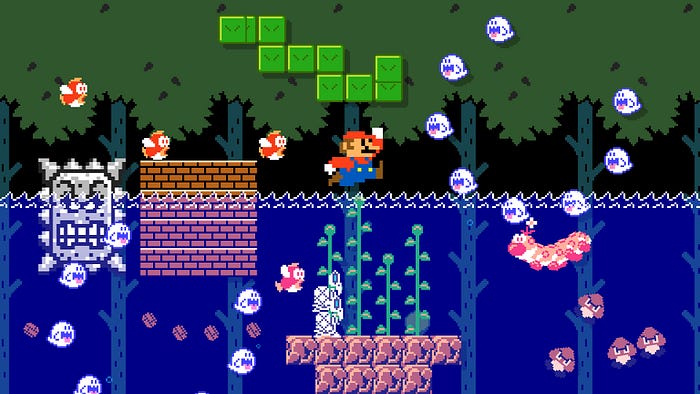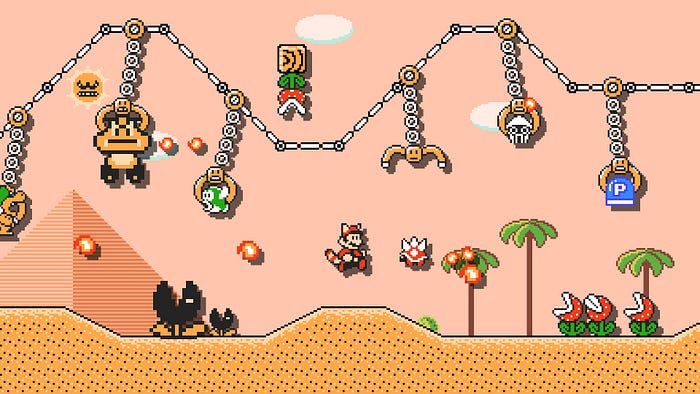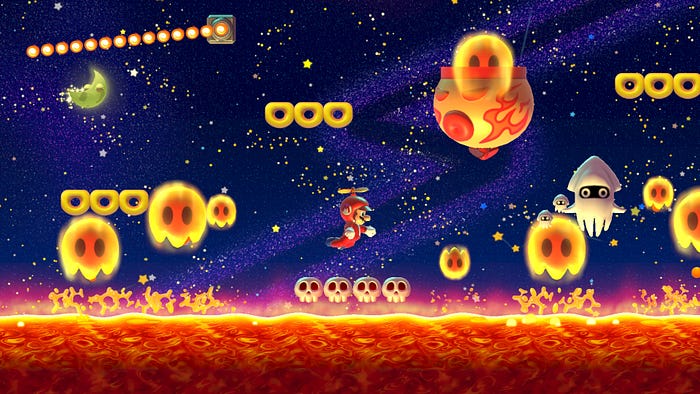Creating Better Courses in Super Mario Maker 2
Three tips to overcome course creator’s block

Like many people in their mid-thirties, I grew up playing Mario games. Much as I adored playing them, I often found myself daydreaming about how I’d create my own Mario. What would it be like to be a Nintendo designer for a day? Just imagine the possibilities! I remember having all sorts of crazy ideas — everything from weird mash-ups to entirely new ways of playing (before I even knew what 3D games were, I distinctly recall the exciting prospect of having Mario run into the background to explore distant locations).
As a kid, I could never have imagined that I’d actually get the chance to design my own Mario courses — but here I am, in 2019, knee-deep in Super Mario Maker 2, a superbly-crafted experience that consists of both an outstanding Mario game and a highly robust game-creation toolkit. Now that the game has been out for a little while, and the flood of reviews has permeated the internet, I’ve noticed one recurring theme: there seem to be a lot of people who’d dearly love to dive into Super Mario Maker 2, but feel daunted by the course creation aspect. Now, you can certainly play and thoroughly enjoy Super Mario Maker 2without ever creating your own course. I’d certainly recommend the game as a fantastic platformer on its own.
But for those of you who are interested in creating your own courses — but perhaps you don’t know where to begin — I thought I’d share three key tips that will help you get started.
I’ve spent a lot of time with the game across all modes, including Yamamura’s Dojo (the fantastic in-game tutorial system). The following tips are drawn from all these experiences. Enjoy, and good luck!

Before I share my top three tips, I do want to throw in a quick freebie: before creating anything in Maker Mode, I highly recommend playing a good amount of Story Mode and Course World. All of the courses across both of these modes have been built using Super Mario Maker 2’s in-game tools and they’ll give you some great inspiration to get started on your own courses.
Tip 1: Build around a single idea
When you first jump into Maker Mode, it’s really tempting (and a lot of fun) to dive in, pick up every object and enemy you can get your sticky fingers on, and fill the screen with them. And while this can be useful for experimentation purposes, it won’t typically make for an enjoyable playing experience.
One of the things you’ll notice about best courses in Story Mode and Course World is that they typically revolve around a single idea or concept — they will repeatedly riff on that same concept in different ways. Some courses are all about running fast the entire time, avoiding obstacles as you go. Others will focus on a particular kind of obstacle (for example, a course made up of mostly lifts, or clear pipes, or moving from room to room solving puzzles to nab keys).
It’s also advisable to build around a very small pool of enemy types; rather than throwing half a dozen different kinds of enemies into a course, it’s often more effective to focus on building platforming challenges around one or two kinds of enemies. The advantage here is that you can create a smooth and enjoyable difficulty curve for players.
For example, you might build a course where the only enemies are goombas and koopa troopers. At the beginning of the course, you might start simply — a goomba here, a koopa there. The initial encounters with these enemies will teach players that you can jump on a goomba’s head to defeat it, and that you can jump on and then kick a koopa’s shell to send it flying. The fun part is taking those very basic mechanics and stacking them in interesting ways throughout the course, building a progressive ramp that gently increases the challenge. So, later on in the course, you might trigger several different events that stem from the player kicking a koopa shell (maybe they kick it into an ON/OFF switch, which causes upcoming platforms to flicker on and off, creating an environmental hurdle).
The key takeaway? Less is more. Start with a single idea (“I’m going to build a course that’s all about the different ways you can squish goombas!”) and that’ll give you a good basis for a playable course.

Tip 2: Experiment!
This might sound like a contradiction to Tip 1, but it really isn’t. Experimentation is really important — you’re not likely to design a perfect course in your very first outing. Even the masters at Nintendo spend a lot of their time experimenting with different ideas; that’s often how they come up with some of their greatest designs. The same rule definitely applies for Super Mario Maker 2 newcomers.
Even if you follow Tip 1 and you start by choosing a single idea or theme to build around, you might still not know what to do next — or how your course will flow from one obstacle to another. That’s perfectly okay! It’s entirely fine to approach Maker Mode with an experimenter’s mindset, rather than diving in with the idea that you’re going to build an entire course in one sitting.
One thing I’ve noticed is that I’ll sometimes have a vague idea of what I want to make, but I’ll build in a very incremental way — often by constructing small, individual obstacles and then repeatedly testing them (more on that in a moment). If each individual obstacle in your course feels good, then the chance of the overall course being enjoyable to play is significantly higher.
Remember, too, that you can view Mario’s movement trails when you move back-and-forth between playing and editing your course. This is one of the Maker Mode’s most invaluable tools; it’ll help you clearly see the arcs of Mario’s jumps, and where he should land after jumping. You can use this immediate visual feedback to create platforming obstacles that are reasonably spaced. You can also use this information to place enemies in a way that is fair to the player (unless you’re building some Kaizo monstrosity, you’ll want to avoid nasty, unavoidable surprises that aren’t clearly telegraphed to the player in advance).

Tip 3: Play test in person if you can
This is perhaps the single most important tip I can provide. You’ll play a huge variety of courses in Super Mario Maker 2, but what is the common ingredient that all of the really fun ones share?
I think a big part of it is the sense of satisfaction players get when they clear a course, but also, the satisfaction they feel as they overcome each obstacle withina course. Making players feel satisfied through your course design isn’t easy — it requires achieving a careful balance between challenge and playability. If your course is too easy, such that it’s a total cakewalk, then it’s unlikely to be much fun. But if it’s impossibly difficult — if the challenge doesn’t feel achievable for the player — then it’s also not likely to be terribly enjoyable.
Super Mario Maker 2 provides numerous tools to help you achieve this balance. The trails I mentioned previously are one big part of that, but so is the fact that you’ll be required to complete your own course before you can upload it (once from the beginning, and once from the checkpoint if you’ve placed one). Another really useful tool comes into the mix once you’ve uploaded your course and other people have started to play it; you’ll actually be able to see little markers where people died. This is incredibly useful, because it’ll show you all of the friction points in your design.
But the most valuable technique is to actually pass the controller to someone else who is sitting right next to you in the same room. Absolutely nothing beats watching a real, live player tackling your course. It’s not just that you’ll see where they are dying — pay attention to their facial expressions and body language.
You’ll gain enormous insight from simply observing. Are there any parts of the course where the player grins, laughs, or screams? What part of the course were they playing in that moment? Do they ever shake their head, frown, or groan? Is there a moment when they stick their tongue out and lift the controller up high out of their lap? What do you think that means?
Having made these observations, you’ll have a pretty good idea about the parts that cause friction and those that are most enjoyable. Try to enhance the good stuff and smooth out (or replace) the bad stuff. Rinse and repeat. Oh, and once they’ve finished playing the course, ask some open-ended questions. What did they enjoy most? If there was a spot that seemed tricky, ask what they were thinking at that moment.
It’s amazing how much you can learn from this kind of play testing. And, if you rapidly iterate and re-test, you might be surprised at how quickly your course design improves.

I hope you enjoyed these tips and find them useful. Super Mario Maker 2 is a surprisingly deep and powerful toolkit — there’s just so much you can do here. If you’re curious about designing courses but feel intimidated, don’t be; try not to worry too much about building a great course at first, just dive in and play with the tools. Make sure to go at your own pace, and if you get frustrated, take a break and play some of the truly wonderful player-created courses in Course World.
And most of all, make sure to have fun! Thanks for reading.
